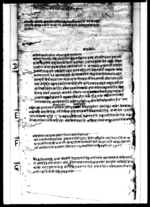A copy of an order from Subedāra Śaṅkhadhara to Patan officials to investigate Rāmananda Bā̃ḍā's claim to the overseership of the Luthāma Guṭha (VS 1860)
ID: E_2253_0015D
Edited and
translated by Manik Bajracharya
in collaboration with
Yogesh Budathoki
Created: 2020-08-17;
Last modified: 2021-03-26
For the metadata of the document, click here
The accompanying edition, translation/synopsis and/or commentary are available under the terms of the Creative Commons Attribution-ShareAlike 4.0 International License
Abstract
This document is a copy of an order of Subedāra Saṅkhadhara to officials of Patan to substantiate the claims of Rāmananda Bā̃ḍā that the Matsyendranātha-related Luthāma Guṭha has been operated by the members of his clan.Diplomatic edition
[1r]
1श्रीमत्स्येंद्र1स्वस्तिश्रीअंवलि•सुवेदार•शंखधरकस्यलिखापत्रम्¯¯¯¯¯¯¯¯¯¯¯¯¯¯¯¯¯¯2आगेसहरपाटनका•डिठ्ठा•रुद्रनारायण•डिठ्ठाभागीराराम•द्वार्या•चंद्रमणिवराल•तुसालको
3द्वार्या•कालुजैसि•विष्णुदेवलकोविचारी•करुणाकर•दुलालकेषुयथोचित•उप्रांत•ओकुवा
4हालटोल•श्रीमाहावुद्दकोननिका•रामानंदवांडाले¯ ¯१¯कोरथमाहालुथामगुठि•हाम्रापुरू
5षाजीवराजज्यूज्यूले•राष्याकोहोभंछन्•दानपत्रहेरूंभंदा•नेपालमार्दा•भाद्गाउंमा•आफ्ना
6आलमालसार्दा•गूठचढायाकापत्र•आलमालसमेत•भोट्यालेखोसिलियाभनिभंछन्•
7तस्अर्थ•चौवीसहजारपाटन्याजान्यामानिसवसाली•निरूपणगर्दा•जीवराजवाडाले•
8राष्याकोहोइन•हाम्रापुरूषालेराष्याकोहोभनि•कोहिभन्नसक्तछत•उस्काहातकोमुचु
9ल्का•लेषाई•लियेरजोरिदेउ•एसैकापुरूषालेराष्याको•लुथामविमानगूठपनिरहेछ•विग्र्या
10कोवस्तु•सपार्न•इनकाघर•आजसंम•राषिजांदारह्याछन्भन्यानविग्र्याकोवस्तुराष्याकाभं
11डारकाताल्चाकोसांचोपनि•अझसम्मइनैकाघरराषिन्यारहेछभन्या•सर्कारवाटपनि•मोहो
12रगरिवक्स्याकोछ•वहालिचलाईदेउ•सर्वथा३इतिसं१८६०साल•मितिआश्विनवदि१२रोज¯¯¯शुभम्
Translation
[1r]
Glorious Matsyendra
Hail! A letter of venerable amālī [and] subedāraŚaṅkhadhara.
Āge: To ḍiṭṭhāRudranārāyaṇa, diṭṭhā Bhāgīrāma, dvāryāCandramaṇi Barāla, Kālu Jaisī (dvāryā of Tusāla) and Karuṇākara Dulāla (bicārī of Viṣṇu Devala) in the city of Patan.
Yathocita uprānta: Rāmānanda Bā̃ḍā, a resident of the courtyard (nani) of glorious Mahābuddha at Oku Bāhāla Ṭola, claims: "The Luthāma Guṭhī1 of the chariot of 1 [i.e., Matsyendra] was donated by our ancestor forefather Jīvarāja." When asked to show the deed of donation, he says: "During the conquest of Nepāla [by the Śāhas], when we were moving our goods to Bhādagāũ2 , the deed endowing the guṭhī was grabbed by Bhoṭyās." For this reason, if investigated in the presence of informed persons among the twenty-four thousand (households/people) of Patan, some may claim: "[The guṭhī] was not endowed by Jīvarāja Bā̃ḍā. It was endowed by our ancestor." If someone claims] so, have his statement written in his own hand and attach it [to this letter].
If it is learned that the Luthāma Vimāna Guṭha was indeed endowed by his (i.e., Rāmānanda's) ancestor, that people still leave broken parts [of the panels] in his house for repairing, and that his household still keeps the key to the storeroom where the intact parts are stored, by all means grant him a bahāli3 [document]. The king, too, has issued a mohara.4
Tuesday5 , the 12th of the dark fortnight of Āśvīna in the [Vikrama] era year 1860 (1803 CE). Auspiciousness.
Commentary
This document is a copy of a letter issued by Subedāra Śaṅkhadhara, the amālī of Patan. This document is the fourth in a series of documents concerning a legal issue that arose in 18026 over the overseership of the Luthāma Guṭha established by Jīvarāja Bā̃ḍā in the 17th century in service to the chariot of Bungadyo.
This document is addressed to two diṭṭhās, two dvāryās and a bicārī officials of Patan who are asked to investigate whether Rāmānanda Bā̃ḍā was the rightful overseer of the guṭha. Śaṅkhadhara orders the officials to allow Rāmānanda to regain control of the guṭha if three conditions apply: that no one else from Patan claims his right to it; that he still repairs broken panels of the vimāna in his own house; and that he still holds the keys to the storeroom where the panels are stored.
The document iterates that the king had issued a mohara to Rāmānanda. This refers to the rukkā (see document E_2253_0015C) issued by the king a month earlier, allowing Rāmānanda to regain control of the guṭha and its land endowments. It is interesting that the local officials are still called upon to investigate the rightful state of affairs at the guṭha when the king already had issued the order deciding the case.
There is another copy of this document in E_2254_0001C.

